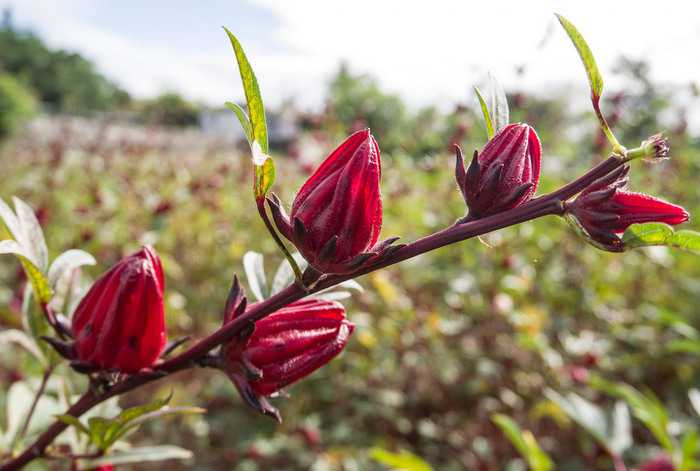Gardening: Phuket’s tasty roselle

PHUKET: I recently launched a series intended to cover fruits, vegetables and herbs that, like the hoary old advertisement for a famous dark stout, “look good, taste good and do you good.”
Thailand is a huge repository of such goodies. And since we are on the topic of liquid refreshment, I am kicking off today’s offering with a member of the hibiscus family quite unrecognizable from the flamboyant varieties such as the rosa-sinensis, the coral-red, fringe-petalled schizopetalus or the rose-like mutabilis.
In fact, the white or yellow flowers of this relative are relatively insignificant. Instead, it is grown primarily for its leaves, and more particularly for its fleshy red calyxes (sepals) which are boiled and reduced to make sauces, jellies and, above all, drinkable concoctions which include a refreshing tea and a cool drink with a flavor reminiscent of cranberry or redcurrant.
While the young fruit can be boiled and eaten with nam prik, it is the calyx, and sometimes the petals, which forms the basis for the beverage that is often found in Thai fresh markets, displayed in large transparent containers which show off its vivid red color. To make it more acceptable to the Thai craving for ultra-sweet drinks, sugar and sometimes salt is added to the mix.
This shrub’s juice is now finding new employment as an additive in red wine produced in Thailand from grape concentrate, giving the mix a fruitiness it would otherwise not have. Don’t ask me how they up the alcohol level to compensate. The name? Roselle, or, to be more technical, H sabdariffa. In some parts of the globe, thanks to slightly astringent taste of the raw leaves, it is known as Jamaican sorrel.
A tallish, narrow plant with deeply lobed foliage which can reach six or seven feet in height, roselle will grow almost anywhere, sometimes colonizing waste ground with its characteristic purplish-red stems and branches.
Outside the rusting corrugated iron shacks of immigrant laborers, it is frequently found growing in clumps. It can be readily cultivated from seeds (available in packets) or from cuttings (the stems are made into a fiber called bast in Africa), and can even be employed to create a temporary hedge or barrier. The leaves are used to create a spicy version of spinach, and in Myanmar are added to traditional curry. In poor Asian communities worldwide it is a staple of people’s diets.
The drink is especially valuable for its role in quenching thirst, reducing body heat and, above all, helping to lower levels of cholesterol. The whole plant has been used for centuries as a folk medicine, serving as a diuretic, a laxative and even as a treatment for serious ailments such as cancer and cardiac problems.
Like the pumpkin, it is a rich source of vitamin A – most red fruits and vegetables, for example the tomato, are – as well as calcium and vitamin C. Most important, it contains one of the highest levels of antioxidants of any widely available food. I think the cooling drink is better without the salt and sugar, so make your own if you can…
No wonder H sabdariffa is becoming of considerable interest to the Western world, which is getting hooked on herbal remedies. The dried calyxes are now being exported to many countries. Malaysia even followed Thailand’s example in encouraging commercial plantings.
Thailand remains, along with China, one of the two leading producers of roselle. Witness the fact that here in Phuket, the dried calyces are often sold in local markets alongside the drink.
It is certainly here to stay. And remember, it not only looks and tastes good, it also does you good…
— Patrick Campbell
Latest Thailand News
Follow The Thaiger on Google News:


























